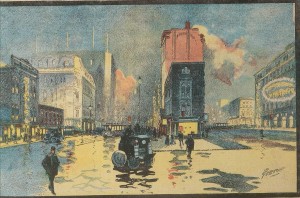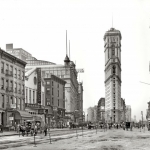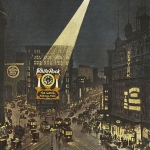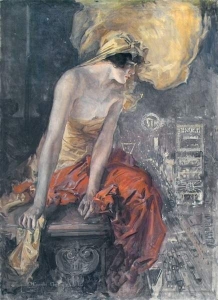The New Broadway—The Street That Knows No Night
[Looking Down Broadway and Seventh Avenue from Long Acre Square—Forty-fourth Street]
Cover illustration for The World Sunday Magazine (November 5, 1899)
In the 19th century, Longacre Square (aka, Long Acre) in New York City was the center of the community’s carriage-making trade and was named for a similar district in London.[i] Located at the intersection of 42nd Street, Seventh Avenue, and Broadway [Bloomingdale Road] up through 47th Street, this nexus of streets opened the way to the north of Manhattan. By the early 1890s this once rural area of the city had become the location of Oscar Hammerstein’s Olympia theater, leading the way to a new identity for the neighborhood as the city’s locus of theaters, restaurants, and blazing electric lights and lighted signage. It was renamed Times Square on April 8, 1904, the name having been suggested by the owner and publisher of the New York Times after the New York Times tower built there.
Photo of New York circa 1904. “Longacre Square”soon to be renamed Times Square after the recently completed New York Times tower seen here.
8×10 inch dry plate glass negative, Detroit Publishing Company.
Joseph Pulitzer’s New York World was one of the most widely read newspapers of its day. The Sunday edition, which could sell as many as half a million or more copies around the United States, was filled with colorful artwork, cartoons, and cultural commentary. At the turn of the twentieth century, one of the World’s most popular illustrators, Louis Biedermann (1874-1957), speculated on the future New York in 1999 in a lavish two-page spread that pictured Manhattan solidly packed with skyscrapers, including behemoth towers at least a hundred-stories tall, sporting landing platforms of airships. Seen above, Biedermann’s illustration shows the sparkle of light from specific signs, the wash of light reflected in the damp street that was cast by large-scale signage, and the glowing light-filled sky. Notice how he projects the absence of horse-drawn vehicles in the city of the future.
Light has defined this public space since its incarnation as Times Square, even to the dropping of the ball of electric lights to mark the new year beginning in
1907. It was the same New York Times owner and publisher, Adolph Ochs, who came up with the idea of dropping the ball of light. The Times did not remain located on the square for long. By 1913 they had moved to another building on West 43rd Street.
1907. It was the same New York Times owner and publisher, Adolph Ochs, who came up with the idea of dropping the ball of light. The Times did not remain located on the square for long. By 1913 they had moved to another building on West 43rd Street.
White Rock ad with tag line, The Great White Way at Times Square
At the corner of 47th Street and Broadway the White Rock electric sign display was famous not only in reality but it was also used for print advertising with an illustrator designed view of the square over-shadowed by the sign. The display included fountains of colorful lights set at either side of the ad’s huge brightly lit clock. Notice how in the print ad a light shines on the sign from an airplane flying over the square. That yellow beam of light makes the focus of the ad more obvious.
Woman looking over Times Square from building ledge, 1921
Cover illustration for Motor (December 1921)
Oil on canvas
Courtesy Illustration House, New York
As seen in the illustration by Louis Biedermann, it only took twenty years from Thomas Edison’s invention of the incandescent lamp in 1879 for Time’s Square to be framed with and focused on the light illuminating and defining it. In another twenty years, the bright light’s of Broadway would help to identify other illustrations such as Howard Chandler Christy’s cover illustration above for Motor magazine (December 1921) of a woman from her perch on a tall building’s ledge and reminding us, ‘all that glitters is not gold.’[ii]
[i] In London the carriage building community was on Long Acre Street. In Manhattan, the first version of the district was called “New York’s Long Acre.” See “The Naming of Long Acre Square” New York Times (March 8, 1903).
[ii] Shakespeare wrote an early version of this line in his play, The Merchant of Venice: ‘all that glisters is not gold.’
January 26, 2012
By Joyce K. Schiller, Curator, Rockwell Center for American Visual Studies, Norman Rockwell Museum










